
|
|
|
|
|
|
Classic Bikes
Custom Bikes
Individual
Racing Bikes AJP
AJS
Aprilia
Ariel
Avinton / Wakan
Bajaj
Benelli
Beta
Bimota
BMW
Brough Superior
BRP Cam-Am
BSA
Buell / EBR
Bultaco
Cagiva
Campagna
CCM
CF Moto
Combat Motors
Derbi
Deus
Ducati
Excelsior
GASGAS
Ghezzi Brian
Gilera
GIMA
Harley Davidson
Hero
Highland
Honda
Horex
Husaberg
Husqvarna
Hyosung
Indian
Jawa
Kawasaki
KTM
KYMCO
Laverda
Lazareth
Magni
Maico
Mash
Matchless
Mondial
Moto Guzzi
Moto Morini
MV Agusta
MZ / MuZ
NCR
Norton
NSU
Paton
Peugeot
Piaggio
Revival Cycles
Roland Sands
Royal Enfield
Sachs
Sherco
Sunbeam
Suzuki
SWM
SYM
Triumph
TVS
Ural
Velocette
Vespa
Victory
Vincent
VOR
Voxan
Vyrus
Walt Siegl
Walz
Wrenchmonkees
Wunderlich
XTR / Radical
Yamaha
Zero
Video
Technical
Complete Manufacturer List
|
Honda CMX 1100 Rebel / DCT
|
| . |
|
Make Model |
Honda CMX 1100 Rebel / DCT |
|
Year |
2021 - 2022 |
| Engine | Four stroke, parallel twin with 270°crank and Uni-cam, SOHC, 4 valves per cylinder |
|
Capacity |
1084 cc / 66.1 cu-in |
|
Bore x Stroke |
92.0 x 81.5 mm |
|
Compression Ratio |
10.1:1 |
| Cooling System | Liquid cooled |
|
Emission |
EURO5 |
| Induction | PGM-FI electronic fuel injection |
| Ignition | Full transistorized ignition |
| Battery | 112V/11.2AH |
| Starting | Electric |
|
Max Power |
64 kW / 85.8 hp @ 7000 rpm |
|
Max Torque |
98 Nm / 72.2 ft-lb @ 4750 rpm |
| Clutch |
MT: Wet multiplate clutch DCT: Wet multiplate hydraulic 2-clutch |
|
Transmission |
MT: 6-speed Manual Transmission DCT: 6-speed Dual Clutch Transmission |
| Final Drive | 525 O-ring chain |
| Frame | Diamond |
|
Front Suspension |
43mm Showa cartridge style fork, preload adjustable |
|
Front Wheel Travel |
122 mm / 4.8 in |
|
Rear Suspension |
Preload adjustable twin Showa piggyback rear shock |
|
Rear Wheel Travel |
96.5 mm / 3.8 in |
|
Front Brakes |
Single 330 mm floating disc, radial mounted monoblock four-piston caliper |
|
Rear Brakes |
Single 256mm disc with single-piston caliper |
|
ABS System |
2 channel ABS |
| Wheels | Multi-spoke cast aluminium |
| Front Rim | MT3.50 |
| Rear Rim | MT5.00 |
|
Front Tyre |
130/70B18 M/C |
|
Rear Tyre |
180/65B16 M/C |
| Rake | 28° |
| Fork Angle | 30° |
| Trail | 110 mm / 4.3 in |
| Dimensions |
Length: 2240mm
/ 88.1 in Width: 853mm / 33.5 in Width -DCT: 834mm / 32.8 in Height: 1115mm / 43.8 in |
| Wheelbase | 1520 mm / 59.8 in |
| Seat Height | 700 mm / 27.5 in |
| Ground Clearance | 120 mm / 4.7 in |
|
Wet Weight |
223 kg / 491.6 lbs - DCT 233 kg / 513.6 lbs |
|
Fuel Capacity |
13.6 Litres / 3.6 US gal |
From a press release issued by Honda:
The A2 licence-friendly 500cc twin-cylinder CMX500 Rebel, released in 2017, fused tradition with ground-breaking new ideas to capture younger riders for whom a motorcycle is so much more than just transport – riders for whom their motorcycle is a lifestyle, an attitude and an expression of individual identity.
The Rebel’s combination of a timeless ‘bobber’ look and a unique, forward-looking, contemporary style earned it immediate popularity in its first sales season. And it has been far from a one-year wonder: in 2019 the Rebel was the third biggest selling custom style machine in Europe. Accessible, easy to ride and live with, by going its own way the Rebel has proved an accomplished success in standard trim. And as a blank canvas for customisation, it has been a machine more than ready for whatever its owner’s imagination has had in store for it.
For 2021, where the Rebel has led, a new motorcycle will follow: the CMX1100 Rebel. By taking the essence of what’s made the smaller bike so special, and adding more performance, more character and a wealth of Honda’s most advanced technology, it offers a step up – or across from a different segment altogether – for a wide range of riders looking for something that extra bit different.
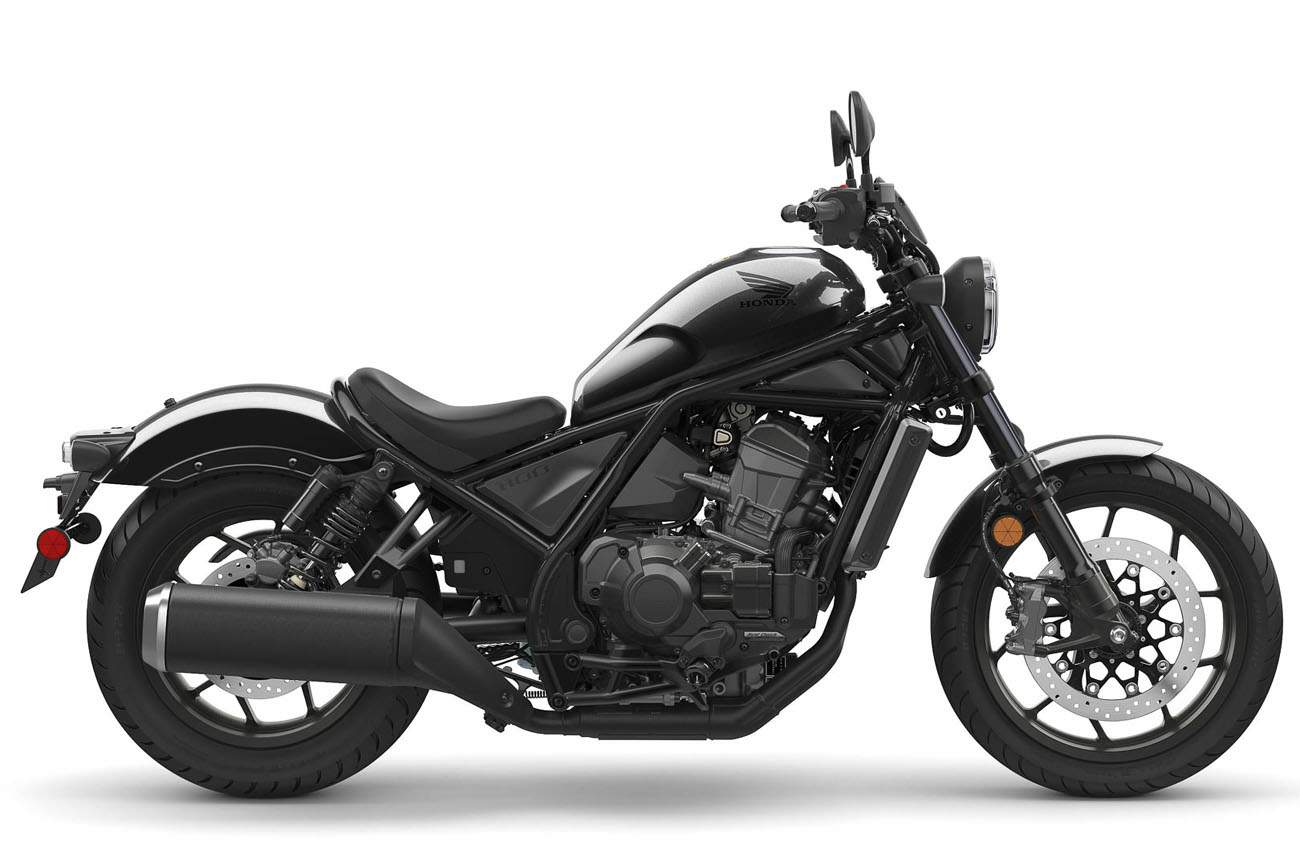
Model Overview
The CMX1100 Rebel has a dual personality. It’s been designed for a leisurely laidback cruise, but also to offer an exciting riding experience when a twisty road presents itself. Riders moving up from smaller bikes will appreciate the manageable dimensions and weight (seat height is a mere 700mm), while more experienced riders will find instant, accessible enjoyment from the chassis’ handling potential, with its stiff tubular steel frame, quality naked bike-spec suspension and high-powered braking.
All-comers will love the character and performance of the 1,084cc parallel twin-cylinder engine (originally used on the CRF1100L Africa Twin), which has been re-tuned for super-strong bottom and mid-range punch and character, plus an evocative, enhanced exhaust note. Throttle By Wire management brings with it sophisticated rider aids: there are 3 default riding modes with a cluster of different parameters to suit riding conditions or rider mood, including engine power delivery, engine braking, the level of Honda Selectable Torque Control and Wheelie Control, and the shift schedule of the optional Dual Clutch Transmission technology. Cruise control comes as standard.
As a 21st century bobber, the Rebel 1100’s stripped-back style speaks volumes with its minimalism. Steel mudguards front and rear sit atop fat tyres; the circular headlight mixes old school looks with new school LED bulbs and mirrors the round, negative LCD instrument display. For modern day convenience, there’s a USB-C charger in the underseat storage space.
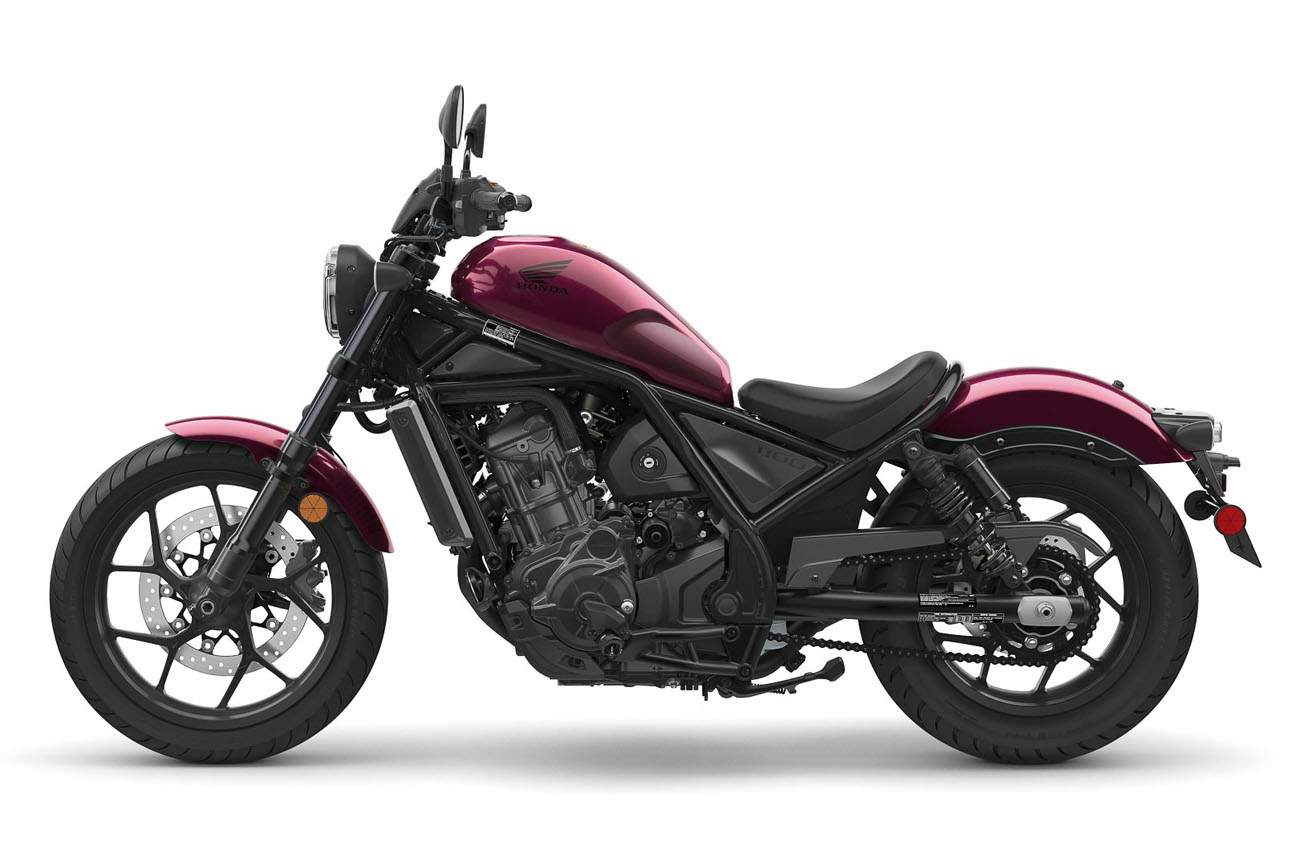
The 2021 Rebel 1100 will be available in the following colour options:
Bordeaux Red Metallic
Gunmetal Black Metallic
Key Features
Styling & Equipment
- Raw style a statement of muscular, stealthy simplicity
- Full LED lighting with 4 bulb LED headlight
- Ignition also opens the seat, which hides storage space and USB-C charger
- Cruise control
The blacked-out CMX1100 Rebel offers a simple, raw and ‘unprocessed’ look created by the same US-based Honda R&D studio that laid down the style of the CMX 500 Rebel. Long and low, with narrow body crowned by a scalloped, two-tone 13.6L flangeless fuel tank, its minimalist presence has real depth, with proportions that are complemented naturally with a rider on board.
Both front and rear mudguards are drawn from 1mm-thick steel and mount with die-cast aluminium brackets. And everywhere you look there are design cues that reinforce the unique overall Rebel look. The low-set 175mm diameter headlight has a classic form but houses four LED bulbs with thick inner lenses for a well-defined frontal signature. The small 55mm circular indicators, too, have classic looks but the oval, clear-lensed LED taillight strikes a contemporary note and chimes with other Rebel details.
The seat is contoured to support the rider under hard acceleration but with soft density for comfort. The Rebel rider can go solo or carry a passenger, as the rear seat pad quickly and easily unbolts. Under the seat there’s a 3L storage compartment which features a USB-C charging point.
An offset 120mm negative LCD instrument display offers intuitive information delivery. The ignition key locates on the left side of the frame and also opens the seat without having to be removed from the ignition. The uncluttered handlebars mount with substantial 1-inch clamps and the left-hand switchgear manages the riding modes and the optional DCT. And for long highway days, cruise control is fitted as standard.
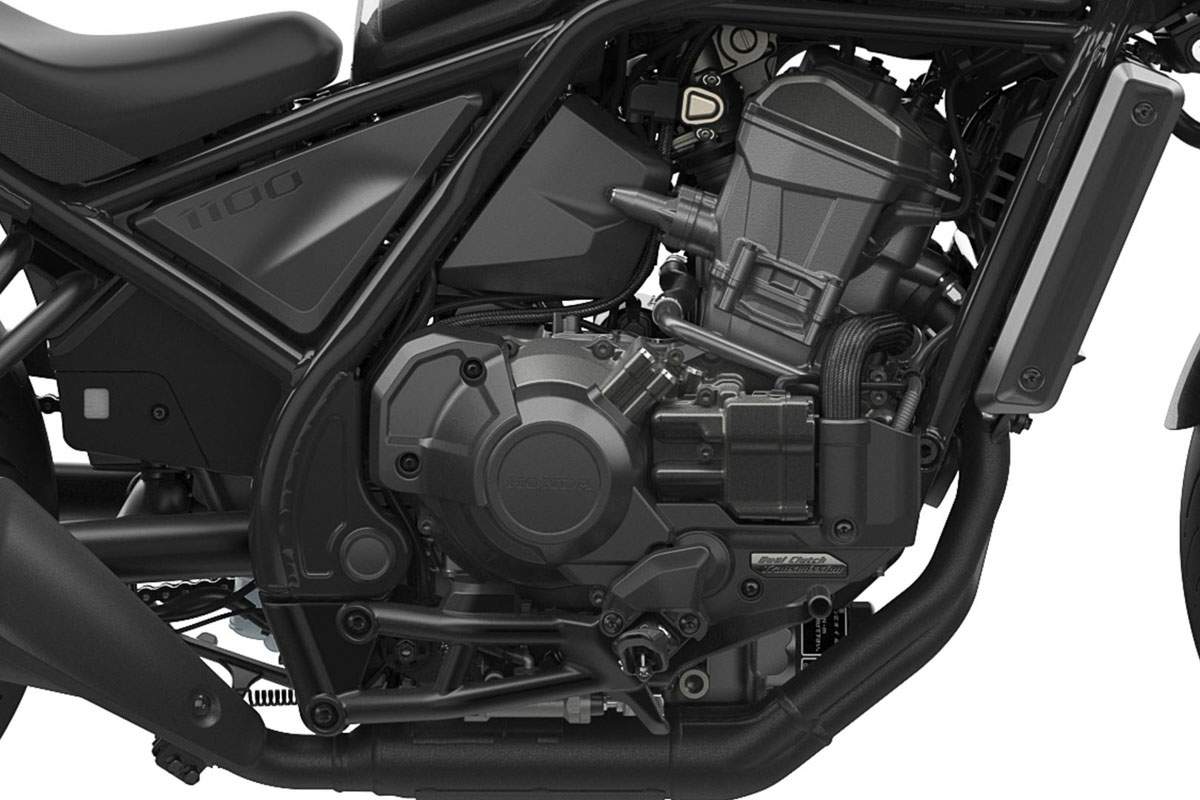
Engine
- 1,084cc parallel twin drawn from the CRF1100L Africa Twin
- Strong performance, with a well-defined character from revised valve timing and ignition settings, plus increased flywheel mass
- Throttle By Wire engine management and tuned exhaust note
The Rebel 1100’s 1,084cc SOHC 8-valve parallel twin-cylinder engine is based on that of the CRF1100L Africa Twin, but with a variety of key changes that have completely altered its nature and feel to cater for its new cruiser duties. Peak power of 64kW @ 7,000rpm with 98Nm @ 4,750rpm peak torque are healthy numbers in this segment of the market, and a guarantee of strong performance. Increased inertia from 32% extra flywheel mass means the low-rpm response is not only extremely strong, but is delivered with real character.
Less obvious – and what makes the engine perfect in this application – is that its compact dimensions (thanks its adventure-bike origins, which gave it a Unicam drive train and semi-dry sump crankcase) centralise mass neatly, making for a low centre of gravity with maximum ground clearance when coupled with the Rebel’s low-slung frame design.
Carried over from Africa Twin is the 270° phased crankshaft and uneven firing interval. But aside from that, the engine exhaust system, valve timing and lift have been altered to generate an even stronger ‘pulse’ feel. And, in keeping with the Rebel’s dual personality, the engine pulse changes from one that responds harmoniously at low revs to all throttle inputs, to a more boisterous, sensation-heightening ‘throb’ as the rpm rises.
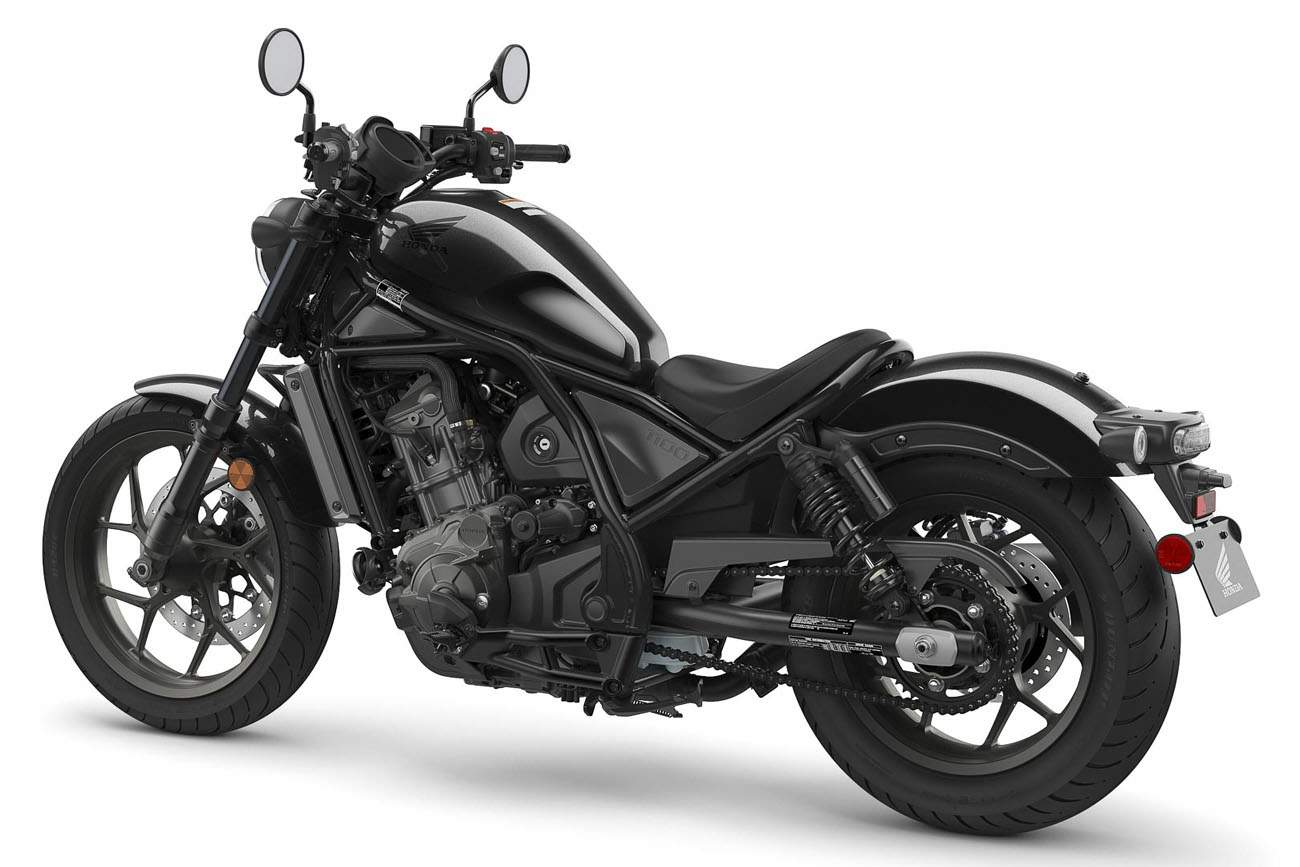
The engine is managed by Throttle By Wire (TBW) and PGM-FI feeds the throttle bodies from a 7L airbox. Adding to riding satisfaction is the exhaust note, which has been tuned to deliver a deep, low-frequency sound pulse through the 5.3L oval-section muffler below 4,000rpm married to a much more powerful, high-frequency note as rpm climbs.
Architecture is unchanged from the Africa Twin; the crankcases split vertically and the water pump is housed within the clutch casing with a thermostat integrated into the cylinder head. Manual and DCT versions of the engine share common crankcases with only minor external differences. Secondary vibrations are neutralised by the mutually reciprocating motion of the pistons, while primary inertial and coupling vibrations are cancelled by the use of biaxial balance shafts. The water and oil pumps are driven by the balancer shafts.
A crank pulsar – with relator teeth spaced at 10° intervals – manages misfire detection, important for OBD2/EURO5 compliance. In addition for EURO5 Linear Air Flow (LAF) sensors in the downpipes give accurate measurement of the air/fuel mixture ratio.
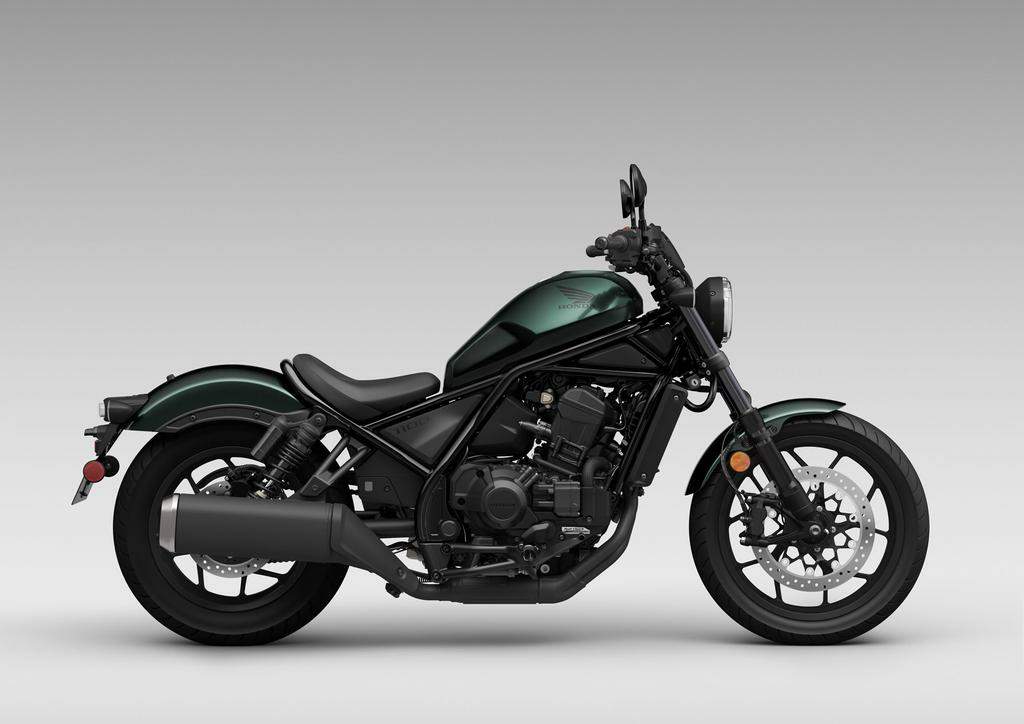
2022
Engine Electronics
- 3 default riding modes to choose from, plus USER customisation
- 3-level Honda Selectable Torque Control and Wheelie Control
TBW manages engine performance and character, plus the level of Honda Selectable Torque Control (HSTC) and Wheelie Control. There are pre-set 3 modes for the rider to choose covering a wide variety of riding conditions. Mode selection is managed from the left-hand switchgear; an indicator in the instrument display activates when HSTC is working.
STANDARD offers a middle setting for engine power delivery, engine braking and Wheelie Control/HSTC, delivering a relaxed ride at low rpm and speeds, while unleashing much more of the Rebel’s potential as the revs rise.
RAIN transmits low engine power delivery and braking, matched to high Wheelie Control and HSTC, for relaxed riding and extra reassurance on wet or slippery surfaces.
SPORT gives aggressive engine power delivery and standard engine braking, with low Wheelie Control and HSTC intervention to allow maximum performance.
USER mode offers the ability to customise between the settings for the preferred combination. Once set, the USER setting is automatically stored so there’s no need to re-set each time the ignition is turned on.
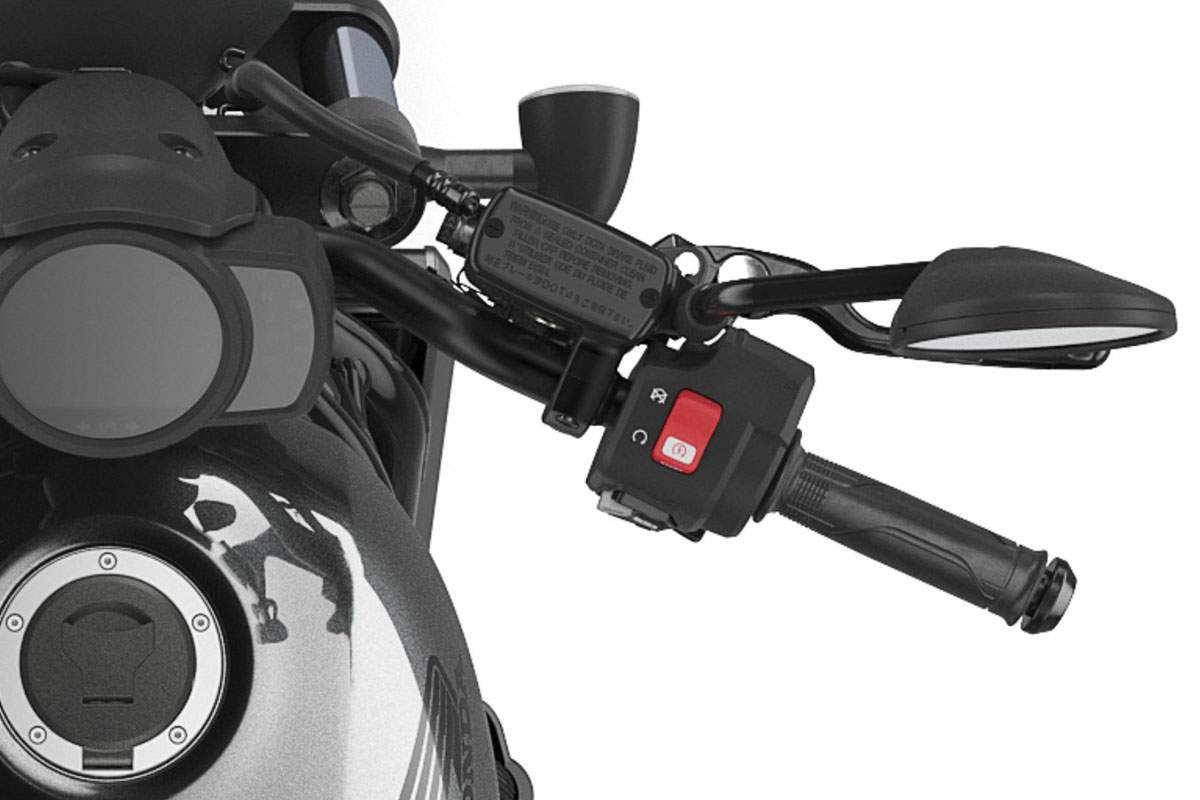
Dual Clutch Transmission
- 3 default D mode (automatic) shifting schedules mirror the riding modes
- USER mode offers customisation
Honda’s DCT technology is now in its eleventh year of production, and over 140,000 DCT-equipped Honda two-wheelers have been sold in Europe since 2010. It delivers consistent, seamless gear changes and very quickly becomes second nature in use. It uses two clutches: one for start-up and 1st, 3rd and 5th, the other for 2nd, 4th and 6th, with the mainshaft for each clutch located inside the other for compact packaging.
Each clutch is independently controlled by its own electro-hydraulic circuit. When a gear change occurs, the system pre-selects the target gear using the clutch not currently in use. The first clutch is then electronically disengaged as, simultaneously, the second clutch engages.
The result is a consistent, fast and seamless gear change. Furthermore, as the twin clutches transfer drive from one gear to the next with minimal interruption of the drive to the rear wheel, any gear change shock and pitching of the machine is minimised, making the change feel direct as well as smooth. Extra benefits include durability (as the gears cannot be damaged by missing a gear) impossibility of stalling, low stress urban riding, reduced rider fatigue and extra ‘brain space’ to concentrate on pure riding aspects such as riding line, cornering, braking and acceleration points.
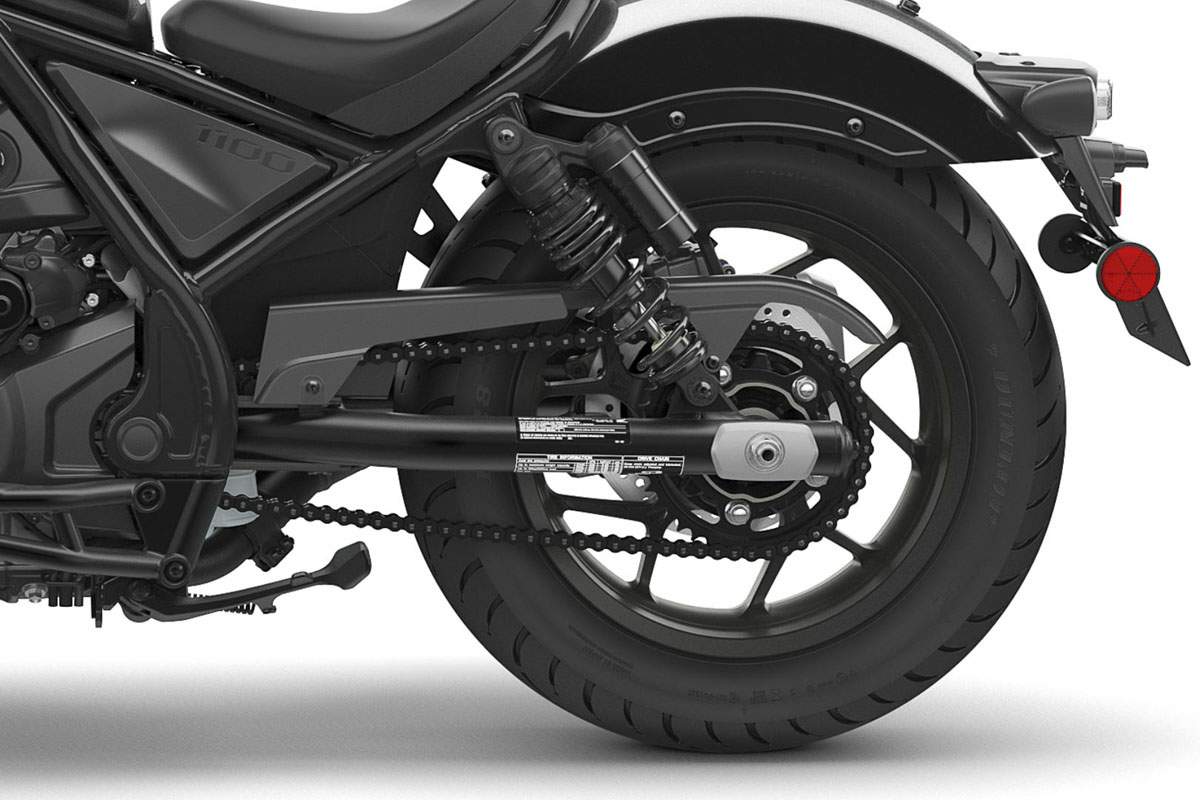
The DCT system offers two distinct riding approaches – the Automatic settings, with pre-programmed shift patterns which constantly read vehicle speed, gear selected and engine rpm to decide when a shift should occur, and the Manual Transmission setting for gear changes using the paddle-shift style triggers on the left handlebar.
Through TBW control, the DCT shift patterns are linked with the 3 riding modes.
In STANDARD riding mode, the DCT shift pattern offers a balance between high-gear, low-speed cruising and low-gear, full-throttle excitement.
RAIN selects higher gears more quickly for a super-smooth ride.
SPORT delivers higher-rpm and lower gears, holds onto revs for longer before upshifts, and downshifting at higher rpms for more engine braking effect.
The USER option also allows the rider to adopt any of the three DCT shift patterns in any riding mode according to preference.
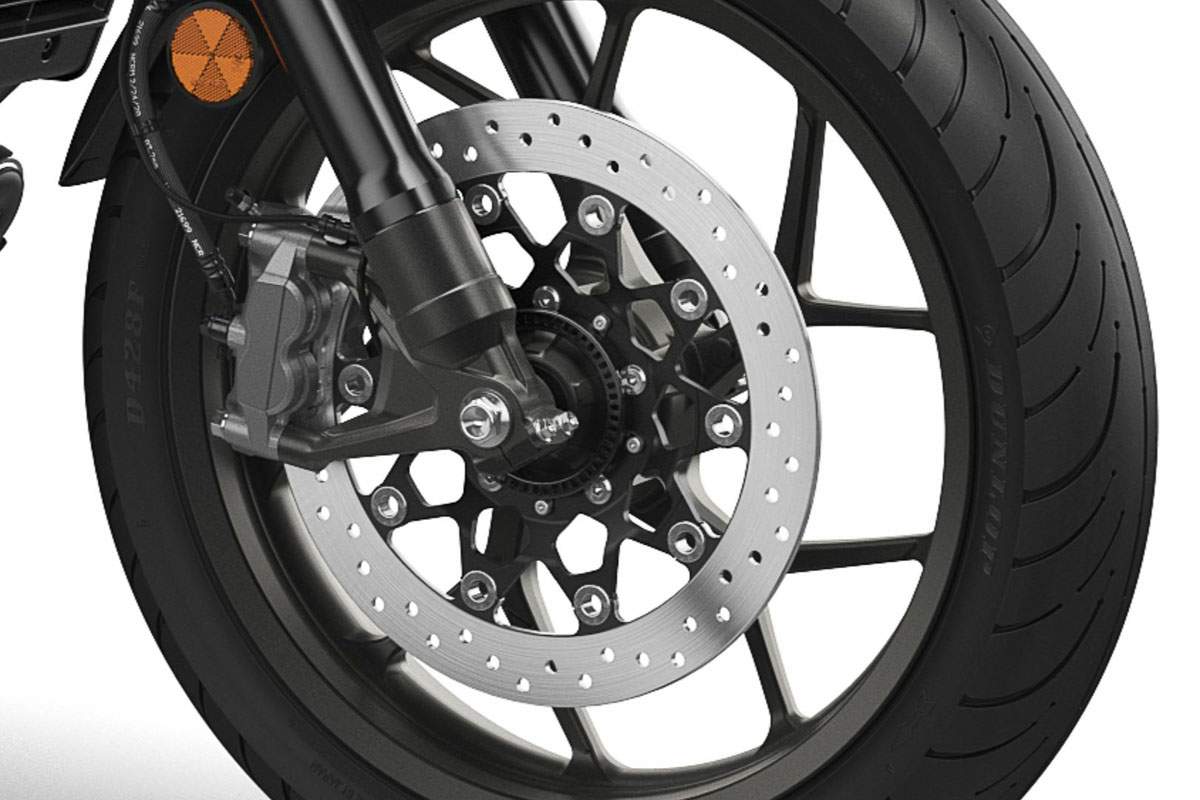
Chassis
- Signature tubular steel frame underpins Rebel styling
- Steering geometry provides stability with easy handling characteristics
- 43mm cartridge-style front forks and piggyback rear shocks, both spring preload adjustable
- Radial mount four-piston front brake caliper and 330mm floating disc
- 130/70B18, 180/65B16 front and rear tyres
A styling statement in itself, the Rebel’s tubular steel frame is based around the raw and simple design of its sibling and features the same defined ‘theme’ line running diagonally front to back, with the fuel tank playing its part sat above the 35mm diameter main tubes which, naturally, are larger than the CMX500 Rebel’s. The 50.8mm diameter swingarm, too has an ‘engineered’ look to match.
Wheelbase is 1,520mm; the forks have a 30° angle for cruiser style, 2° offset from the 28° ‘rake’ line itself; trail is 110mm. This combination delivers the right look, but also straight-line stability and accurate, easy handling. Wet weight is set at 223kg for the standard Rebel 1100 and 233kg for the DCT-equipped option.
Seat height is a very manageable 700mm and the triangle between handlebars, seat and mid-mount footpegs places the rider firmly ‘in’ the motorcycle. The overall geometry allows generous lean angles of 35° each side (as measured by Honda), meaning the Rebel 1100 can enjoy a twisty ‘canyon’ ride and clip apexes with the best of them.
The cartridge-style front forks feature blacked-out 2-piece lowers (manufactured from both extruded and die-cast aluminium) mated to 43mm stanchions finished in a dark navy titanium oxide coating. Twin rear shocks feature a 12.5mm rod and pressurised ‘piggyback’ reservoir. Both front and rear suspension are adjustable for spring preload.
Braking power is served up by a front radial-mount monoblock four-piston caliper biting a 330mm floating disc and rear single piston caliper/256mm disc, both managed by ABS. Cast aluminium wheels feature 5 sporty Y-shaped spokes and wear fat tyres; a 180/65B16 rear and 130/70B18 front.
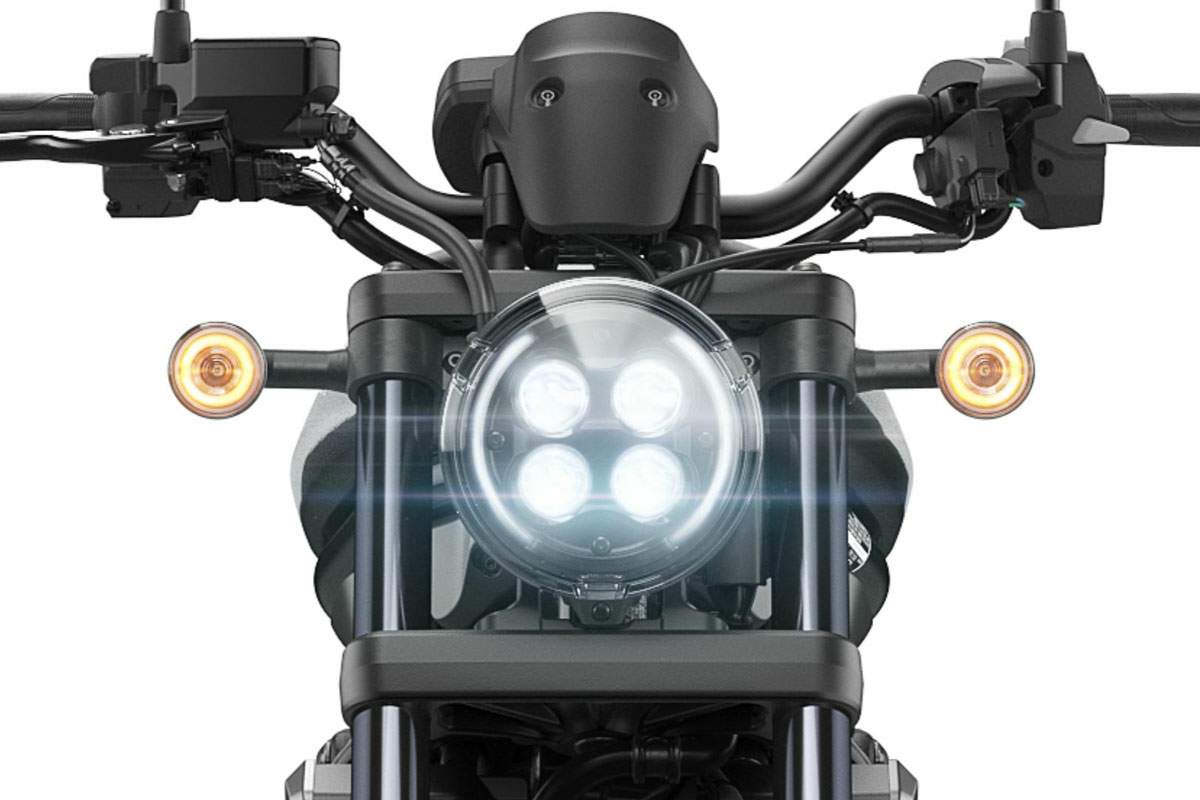
Accessories
As a motorcycle born to be accessorised there are a range of Honda Genuine Accessories ready to bolt straight on to the Rebel 1100.
These are grouped into two categories with different customer styles in mind: the
“street” and the “tour” line-ups:
‘STREET’
Wadding Seat - Standard/forward set replacement black/brown seats
Rear rack (solo type)
Tank pad
Headlight fairing
Short front mudguard
Wheel stripes
‘TOUR’
Wadding Seat - Standard/forward set replacement black/brown seats
Passenger back rest
Rear rack
Fabric saddlebag
Screen
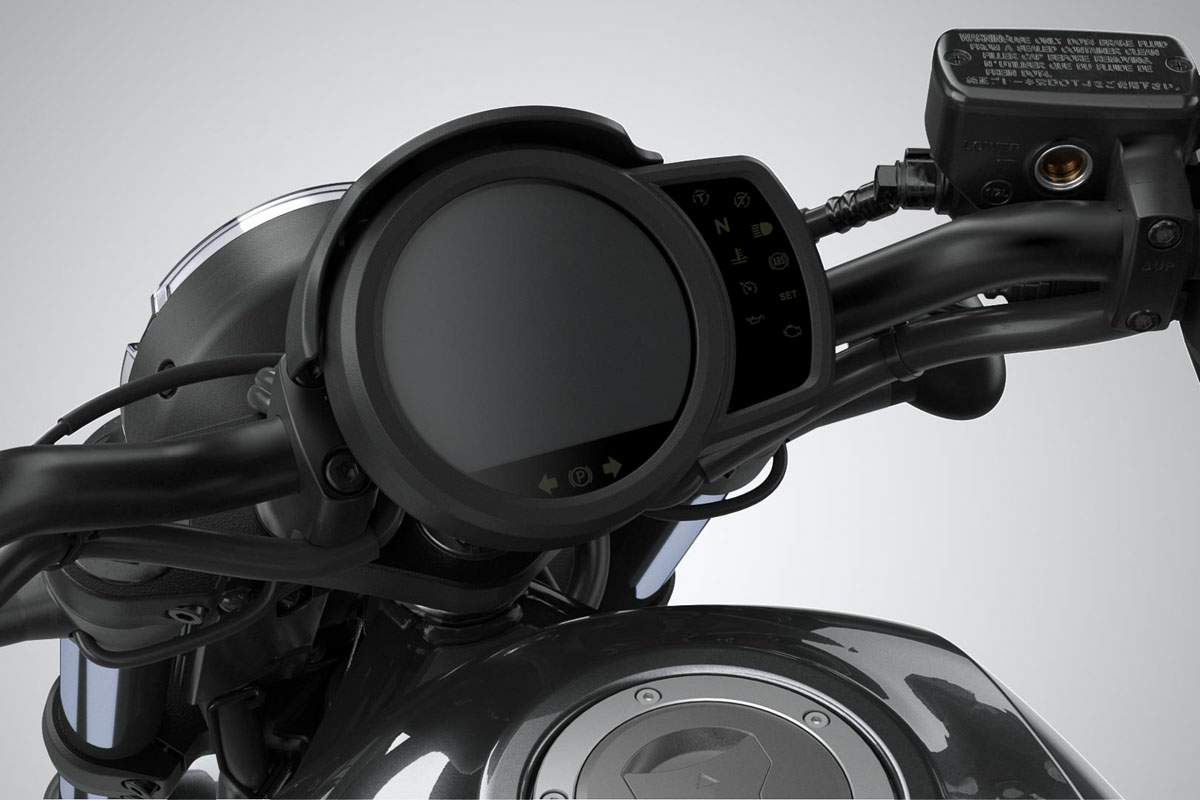
|
Any corrections or more information on these motorcycles will be kindly appreciated. |